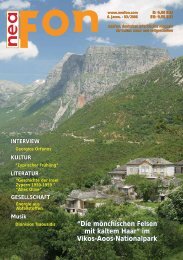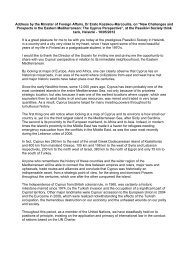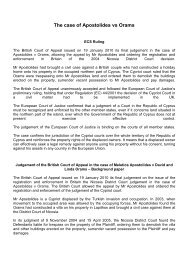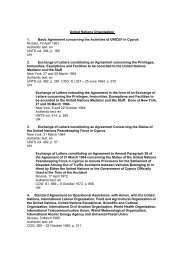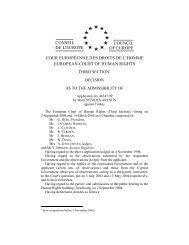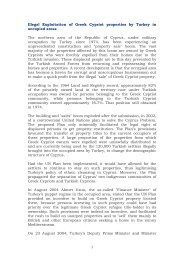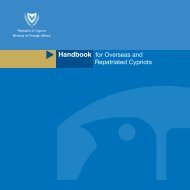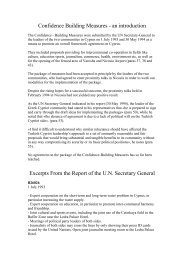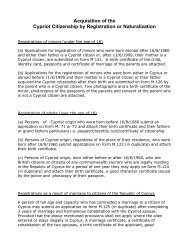Maronites - Ministry of Foreign Affairs
Maronites - Ministry of Foreign Affairs
Maronites - Ministry of Foreign Affairs
Create successful ePaper yourself
Turn your PDF publications into a flip-book with our unique Google optimized e-Paper software.
CYPRUS RELIGIOUS GROUPSTHE<strong>Maronites</strong>OF CYPRUS
CYPRUS RELIGIOUS GROUPSTHE<strong>Maronites</strong>OF CYPRUS
ContentsForeword 5A Message from the Representative <strong>of</strong>the Maronite Religious Group 7A Brief History 8Byzantine Era 8Frankish Era 8Venetian Era 9Ottoman Era 9British Era 10Independence Era 11Demographic Pr<strong>of</strong>ile 16Important Personalities 17Cypriot Maronite Arabic 18The Maronite Archbishopric <strong>of</strong> Cyprus 18Churches, Monasteries and Chapels 19Educational Institutions 23Foundations and Clubs 24Monuments 26Cemeteries 28Mass Media 29Chronology 30References 34
ForewordUnder the Constitution <strong>of</strong> the Republic <strong>of</strong> Cyprus, the Armenians, the Latins and the <strong>Maronites</strong> <strong>of</strong> Cyprus arerecognized as “religious groups”. In a 1960 referendum, the three religious groups were asked to choose tobelong to either the Greek Cypriot or the Turkish Cypriot community. They opted to belong to the Greek Cypriotcommunity. The members <strong>of</strong> all three groups, therefore, enjoy the same privileges, rights and benefits as themembers <strong>of</strong> the Greek Cypriot community, including voting rights, eligibility for public <strong>of</strong>fice and election to <strong>of</strong>ficialgovernment and state positions at all levels. Moreover, the Armenian, Latin and Maronite religious groups, whichvote in the Parliamentary Εlections as part <strong>of</strong> the Greek Cypriot community, elect also one Representative eachfrom their ranks to the Cyprus House <strong>of</strong> Representatives. These non-voting Representatives attend meetings butdo not participate in the House deliberations. Nevertheless, they are consulted on legislative issues <strong>of</strong> particularinterest to their respective group.The series <strong>of</strong> publications “Cyprus Religious Groups” is intended as a basic overview, an introductory pr<strong>of</strong>ile, onthe Armenians, the Latins and the <strong>Maronites</strong> <strong>of</strong> Cyprus. These short publications are by no means exhaustive onthe subject and do not deal with differences <strong>of</strong> opinion and interpretation that may exist among scholars andother experts on issues related to the three groups.This publication series, initiated by the Press and Information Office, has been undertaken with the closecooperation <strong>of</strong> the Representatives <strong>of</strong> the three religious groups in the House <strong>of</strong> Representatives, and theirsignificant contribution is deeply appreciated. They kindly undertook the preparation <strong>of</strong> the text and alsoprovided the photographic material. They, therefore, deserve the credit and are also responsible for thecontent. The Press and Information Office undertook the overall coordination and production <strong>of</strong> the publicationsincluding editing, designing and printing.It is our hope that this series will stimulate more public and scholarly interest about the Armenian, the Latinand the Maronite religious groups <strong>of</strong> Cyprus.DirectorPress and Information Office5
THE MARONITES OF CYPRUSA Message from the Representative <strong>of</strong> the Maronite Religious Groupin the House <strong>of</strong> Representatives, Mr Antonis Haji RoussosDear reader,The publication you hold in your hands presents, in brief, the Maronite community <strong>of</strong>Cyprus: its history, its cultural identity, its presence and its contribution to Cypriotsociety.The history <strong>of</strong> the <strong>Maronites</strong> is a story <strong>of</strong> persecution and <strong>of</strong> the struggle <strong>of</strong> the<strong>Maronites</strong> to preserve their faith, their freedom and their very existence. Cyprus wastheir refuge in the late 7th century when, because <strong>of</strong> Arab raids in Syria, theyimmigrated to the island. Today the <strong>Maronites</strong> <strong>of</strong> Cyprus are refugees again, as aresult <strong>of</strong> the 1974 invasion <strong>of</strong> Cyprus by Turkey. All <strong>of</strong> the island’s Maronite villages (Asomatos, Ayia Marina,Karpasha and Kormakitis) are still under Turkish military occupation.The most serious problem the Maronite community <strong>of</strong> Cyprus faces is its survival as an entity and the preservation<strong>of</strong> its identity. The community underwent a radical change as a result <strong>of</strong> the 1974 invasion <strong>of</strong> Cyprus by Turkeyand the forcible dislocation and detachment <strong>of</strong> the <strong>Maronites</strong> from their villages and, consequently, their churchesand schools. Since 1974, the <strong>Maronites</strong> <strong>of</strong> Cyprus have been struggling for their survival. With the support <strong>of</strong> thegovernment <strong>of</strong> Cyprus, however, and an intensive effort on the part <strong>of</strong> the <strong>Maronites</strong> themselves, the <strong>Maronites</strong>today constitute an organised community, active in the cultural, social and financial sectors <strong>of</strong> our homeland.Nevertheless, the <strong>Maronites</strong>’ desire remains to return to their villages and to coexist harmoniously with all <strong>of</strong> theisland’s diverse communities in a reunited homeland.I hope this informative publication will contribute to the effort to inform and to better understand the <strong>Maronites</strong>.It is published in the hope that it will promote multiculturalism and cultivate respect for diversity; that it willcontribute to the peaceful coexistence <strong>of</strong> all <strong>of</strong> the island’s communities and continued cooperation betweenthem. On behalf <strong>of</strong> the Maronite community, I wish to express warm thanks to the Press and Information Officefor taking the initiative to issue this publication and to the government <strong>of</strong> Cyprus for its longstanding support <strong>of</strong>our community.7
THE MARONITES OF CYPRUSA Brief History●The chapel <strong>of</strong> the Virgin Mary in Kambyli.Byzantine Era: The first appearance <strong>of</strong> <strong>Maronites</strong> in Cyprus dates to the late 7th century (686 AD), during thereign <strong>of</strong> Byzantine Emperor Justinian II – the <strong>Maronites</strong> arrived on the island in flight from Arab raids and religiousclashes in Syria and Lebanon. Cyprus became a safe haven for the <strong>Maronites</strong>, who continued to arrive on theisland up until the early 8th century, choosing to immigrate to Cyprus whenever they faced severe pressure fromtheir religious opponents. In 938 AD, after the Arab destruction <strong>of</strong> Saint Maron’s Monastery in Apamea, Syria, alarge wave <strong>of</strong> <strong>Maronites</strong> left the region for a number <strong>of</strong> neighbouring countries, amongst them Cyprus; it was alsoduring this period that the Maronite Patriarchate was relocated to Lebanon. In 1090 the <strong>Maronites</strong> established amonastery dedicated to Saint John the Chrysostom in the village <strong>of</strong> Koutsovendis in the Kyrenia district.Frankish Era: A large wave <strong>of</strong> <strong>Maronites</strong> immigrated to the island in the late 12th century, after the purchase<strong>of</strong> Cyprus by the Frankish King <strong>of</strong> Jerusalem, Guy de Lusignan, in 1192. The Frankish King, who wished to establisha Western-type feudal kingdom on the island, encouraged the settlement <strong>of</strong> <strong>Maronites</strong> to bolster the Catholicpresence on the island, but also to use them as military garrisons. The <strong>Maronites</strong> enjoyed special privilegesunder this administration and their number increased to about 60.000. In 1224 they resided in 62 villages, mainlyaround the Pentadactylos mountain range. By the early 14th century, their number increased to about 80.000 in72 villages, many <strong>of</strong> which they founded themselves. During the Frankish Era, <strong>Maronites</strong> established the Monastery<strong>of</strong> Saint George <strong>of</strong> Attalou in the Kharcha region on the Pentadactylos mountain range. It was also during thisperiod that the Maronite Archbishopric <strong>of</strong> Cyprus was established, with Nicosia as its seat (1316).8
Talousraportoinnin sisäisen valvonnan kehityshankkeet vuonna 2012Citycon Oyj on jatkanut vuoden 2012 aikana talousraportointiprosessien sisäisten kontrollien kehittämistä, valvontaa ja jatkuvaaseurantaa. Tämä perustuu Citycon Oyj:n hallituksen keväällä 2010 käynnistämään hankkeeseen, jossa yhtiön merkittävien toimintaprosessiensisäisen valvonnan menettelyt käytiin läpi ja kuvattiin kirjallisesti. Määrittelytyöhön osallistuivat Citycon Oyj:n konsernitoimintojenedustajien lisäksi myös yhtiön kunkin toimintamaan yksiköt, mikä mahdollisti koko konsernin kattavan harmonisoidunkontrolliympäristön rakentamisen ja käyttöönoton. Kontrollitestauksen laajuutta täydennettiin vuoden 2012 aikana Suomessa jaRuotsissa, joissa palkanlaskentaprosessi sisällytettiin uutena prosessina kontrollien testauksen piiriin kuuluvaksi.Tilikauden aikana kontrollipisteiden tehokkuus testattiin ja havaitut puutteet arvioitiin, sekä tehtiin tarvittaessa toimenpidesuunnitelmapuutteiden korjaamiseksi. Konsernihallinto arvioi testauksen ja arvioinnin jälkeen havaitut puutteellisuudet yksittäisinäpoikkeamina sekä koottuna yhteen muiden poikkeamien kanssa. Konsernihallinnon laatiman yhteenvedon perusteella ei ole viitteitäsiitä, että kontrollipoikkeamat voisivat aiheuttaa Citycon Oyj:n tilinpäätökseen olennaisia virheellisyyksiä.Citycon Oyj:n sisäisen valvonnan osa-alueita on kuvattu seuraavassa. Kuvauksessa on otettu huomioon vuonna 2010 aloitettusystemaattinen sisäisen valvonnan kehitystyö. Kuvaus perustuu kansainvälisesti tunnettuun Committee <strong>of</strong> Sponsoring Organizations<strong>of</strong> the Treadway Commission-viitekehykseen (COSO), joka on omaksuttu Citycon Oyj:n sisäisen valvonnan viitekehykseksi kehitysprojektin aikana. Otsikointinoudattaa COSO:n eri osa-alueita: valvontaympäristö, riskien arviointi, valvontatoiminnot, viestintä ja tiedotus sekä seuranta.ValvontaympäristöCitycon Oyj:n hallituksella on pääasiallinen vastuu talousraportointiprosessien sisäisestä valvonnasta. Yhtiön hallinnointiohjesääntöönsisältyvät hallituksen ja sen valiokuntien kirjallisen työjärjestykset, jotka täsmentävät hallituksen ja sen valiokuntien työnjakoaja vastuita. Hallituksen tarkastusvaliokunta arvioi taloudellista raportointiprosessia ja sisäisen valvontajärjestelmän asianmukaisuuttasekä käsittelee sisäisen tarkastuksen tuottamia raportteja. Tarkastusvaliokunnan tehtäviä on esitelty tarkemmin edellä hallituksenja valiokuntien esittelyn yhteydessä.Sisäisen valvonnan järjestelmän ylläpito on määritelty toimitusjohtajan tehtäväksi.Talousraportointiprosessin sisäiseen valvontaan liittyviä ohjeistuksia ja menettelytapoja ovat mm. seuraavat: yhtiön hallinnointiohjesääntö,joka sisältää hallituksen ja sen valiokuntien työjärjestykset ja ohjeet hallituksen, toimitusjohtajan sekä johtoryhmänvälisestä työnjaosta; päätösvaltuudet sisältäen euromääräiset hyväksymisrajat; Cityconin laskentaperiaatteet ja raportointiohjeetja riskienhallinnan periaatteet, rahoituspolitiikka sekä yksityiskohtaiset prosessitasoiset kontrollitaulukot.Kaikilla Citycon-konsernin työntekijöillä on kirjallinen toimenkuvaus, joka sisältää keskeiset tehtävät ja vastuualueet sekä toimivaltuudet.Toimenkuvaukset tarkistetaan kaksi kertaa vuodessa pidettävissä kehityskeskusteluissa, joissa arvioidaan myös kunkintyöntekijän suoriutumista suhteessa määriteltyihin tavoitteisiin.Budjetointi- ja suunnitteluprosessiBudjetointi on säännöllinen osa yhtiön toimintaa käsittäen vuosisuunnittelun ja tavoitteiden asettamisen. Budjettiprosessin kauttaCitycon-konsernin henkilökunnalle asetetaan vuosittain taloudelliset ja muut tavoitteet. Ensin asetetaan konsernitason tavoitteet,jotka muunnetaan sitten liiketoiminta-alueiden tavoitteiksi ja työntekijöiden henkilökohtaisiksi tavoitteiksi kyseiselle kaudelle. Konsernitasonja liiketoiminta-aluetason taloudellisia tavoitteita seurataan johdon kuukausiraportoinnissa ja liiketoimintakatsaustenyhteydessä. Työntekijätason tavoitteita seurataan kahdesti vuodessa pidettävissä kehityskeskusteluissa. Yhtiöllä on kannustinjärjestelmä,joka ohjaa konsernia kaikilla tasoilla asetettujen tavoitteiden saavuttamiseen.Toimitusjohtaja raportoi hallitukselle kaikki merkittävät poikkeamat asetetuista ja hallituksen hyväksymistä tavoitteista. Hallitusmyös arvioi vuosittain tavoitteiden saavuttamista ja päättää tavoitteiden saavuttamisen perusteella maksettavista kannustinpalkkioista.Riskien arviointiKonsernin kattava riskienhallinta on osa Cityconin vuosisuunnittelua ja johtamistaCitycon Oyj:ssä on käytössä kokonaisvaltainen riskienhallintaohjelma (Enterprise Risk Management, ERM). Riskienhallinta on osayhtiön sisäistä valvontaa ja sen tarkoituksena on varmistaa yhtiön liiketoiminnallisten tavoitteiden saavuttaminen. Yhtiön hallitus onhyväksynyt määritellyt riskienhallinnan periaatteet ja riskienhallintaprosessin. Riskienhallintaprosessi käsittää yhtiön liiketoiminnastaaiheutuvien ja siihen olennaisesti liittyvien riskien tunnistamisen, arvioinnin, mittaamisen, rajaamisen ja valvonnan.Talousraportoinnin prosessien riskiarvio tunnistaa talousraportointiin liittyvät riskitOsana sisäisen valvonnan kehityshanketta vuonna 2012 Citycon Oyj on tunnistanut talousraportoinnin kannalta merkittävät prosessitja arvioinut niihin liittyviä riskejä. Kuluneen tilikauden aikana riskiarvio päivitettiin osana sisäisten kontrollien testausta. Riskienarviointiin on osallistunut konsernin taloushallinnon lisäksi myös liiketoiminta-alueiden talousjohto. Citycon Oyj:llä on talousrapor-CITYCON OYJ | SELVITYS HALLINTO- JA OHJAUSJÄRJESTELMÄSTÄ 2012 10
THE MARONITES OF CYPRUS●The picturesque chapel <strong>of</strong> Saint George <strong>of</strong> the Seed in Kormakitis.In 1735 two Maronite monks were sent to Cyprus,Cypriot Petros and Lebanese Macarius. These twopioneering monks built the Prophet Elias Monasterynear the village <strong>of</strong> Ayia Marina Skyllouras. The number<strong>of</strong> <strong>Maronites</strong> gradually increased and by 1776 thecommunity numbered 503 persons in 10 villages andin the towns <strong>of</strong> Nicosia and Larnaka. Thanks to theintervention <strong>of</strong> the French Consul, the <strong>Maronites</strong>returned in 1840 under the jurisdiction <strong>of</strong> theirArchbishop, who resided in Lebanon. He was repre -sented in Cyprus by a Chorepiscopus (a church <strong>of</strong>ficial,below the rank <strong>of</strong> a Bishop, whose jurisdiction isconfined to rural districts). During the Tanzimat period(1839-1876), a period <strong>of</strong> fundamental reforms withinthe Ottoman Empire, the Maronite Chorepiscopusparticipated in the Administrative Council (Mejlis Idare).The 19th century found about 1.500 <strong>Maronites</strong>inhabiting six villages: Asomatos, Ayia Marina, Kambyli,Karpasha, Kormakitis and Vouno.British Era: The British period, 1878-1960, definitivelychanged the prevalent political and social conditions inCyprus. The progressive administration and thepromotion <strong>of</strong> pluralism and religious freedom bolsteredthe smaller communities <strong>of</strong> Cyprus. The <strong>Maronites</strong>, whowere a closed society, took advantage <strong>of</strong> thesefavourable conditions and the urban develop ment thataccompanied them and many moved from their villagesto the towns, particularly Nicosia. They retained, how -ever, a special link with their land and villages, onlyfour <strong>of</strong> which had remained: Asomatos, Ayia Marina,Karpasha and Kormakitis. Those who remained in thevillages were mainly engaged in agricul ture andfarming, while those who moved to the towns practisedliberal pr<strong>of</strong>essions or found employ ment in the privateor public sector. Modest and industrious, the <strong>Maronites</strong>have always contributed to the progress <strong>of</strong> Cyprusthrough their work and volunteer activities. A number<strong>of</strong> <strong>Maronites</strong> even volunteered during the World Wars(1914-1918 and 1939-1945).10
THE MARONITES OF CYPRUS●The Prophet Elias Monastery near Ayia Marina Skyllouras had forcenturies been the <strong>Maronites</strong>’ spiritual centre (1945).● From the restoration <strong>of</strong> the Virgin Mary church in Kambyli (1956).●Saint Marina’s church in Ayia MarinaSkyllouras (2010).●Saint George’s cathedral at Kormakitis square.The new favourable conditions facilitated the demo -graphic growth <strong>of</strong> the Maronite community and helpedimprove the quality <strong>of</strong> life <strong>of</strong> the <strong>Maronites</strong>. The com -munity developed culturally and socially, establishingorganised groups, churches, associa tions and schools.In 1928 Kormakitis and Ayia Marina each establisheda Cooperative Credit Society, amongst the first inCyprus. The Asomatos Co-Op followed in 1929, theKarpasha Co-Op in 1930. Today, only the KormakitisCo-Op remains in operation.Independence Era: With the establishment <strong>of</strong> theRepublic <strong>of</strong> Cyprus in 1960, <strong>Maronites</strong> were recognisedas a religious group and were represented by anelected Representative in the Greek CommunalChamber. This was a result <strong>of</strong> the 1960 referendum inwhich they decided to belong to the Greek-Cypriotcommunity, along with the Republic’s other twocon stitutionally recognised religious groups, theArmenians and the Latins (Articles 2 and 109 <strong>of</strong> theConstitution). The <strong>Maronites</strong>, according to Article 109 <strong>of</strong>11
THE MARONITES OF CYPRUS● Maronite Vicar General, Fr. John Foradaris, welcomes Governor Sir Hugh Foot and his wife Sylvia in Kormakitis (1959).the Constitution <strong>of</strong> the Republic <strong>of</strong> Cyprus, wererepresented in the Greek Communal Chamber by amember <strong>of</strong> the Chamber elected by and from withintheir community. As a result <strong>of</strong> the inter-communalclashes between Greek and Turkish Cypriots in 1963-1964, the Greek Communal Chamber was abolished in1965, and since then the Maronite community has been●Archbishop Elias Farah and Chorepiscopus John Foradaris welcomePresident Makarios in Kormakitis (1960).●Saint Sharbel's church in Limassol.12
THE MARONITES OF CYPRUS●Photograph from the 2007 pilgrimage to the ruinedMonastery <strong>of</strong> Prophet Elias.●The 15th century wooden cross, which is kept at theHoly Cross church in Karpasha.● Visit <strong>of</strong> Lady Sylvia Foot at Kormakitis School for Girls (1959).represented in the House <strong>of</strong> Representatives by anelected Representa tive (Law 12/1965).The <strong>Maronites</strong> were only slightly affected during the1963-1964 inter-communal clashes between Greek andTurkish Cypriots; among the community’s minimalcasualties <strong>of</strong> the conflict was the Maronite church <strong>of</strong>the Virgin Mary in the village <strong>of</strong> Kambyli, which wasseized and converted into a grocery store. However,the Maronite community sustained a serious blow asa result <strong>of</strong> the 1974 Turkish invasion: all Maronitevillages were occupied by the invaders, rendering 8013
THE MARONITES OF CYPRUS●View <strong>of</strong> TurkishoccupiedAsomatos.percent <strong>of</strong> the island’s <strong>Maronites</strong> refugees, while about 5 percent remained enclaved in Asomatos, Karpasha andKormakitis. Seven <strong>Maronites</strong> were killed during the war and one is still missing. The Turkish Air Force bombedthe renowned Prophet Elias Monastery and the village <strong>of</strong> Ayia Marina and seized the following churches: SacredHeart <strong>of</strong> Jesus in Famagusta, Saint Anthony in Kythrea, Saint Romanos in Vouno, the Virgin Mary in Kambyli andthe Virgin Mary <strong>of</strong> Marki. The village <strong>of</strong> Ayia Marina Skyllouras was taken over by the Turkish military authoritiesand was turned into a military zone – it remains inaccessible to this day. Access to the village <strong>of</strong> Asomatos, in theKyrenia district, is also restricted, and its inhabitants are allowed into the village only on Sundays to celebrateMass at the church <strong>of</strong> Archangel Michael.Tied to their land and unsure <strong>of</strong> the future <strong>of</strong> their community away from their villages and churches, a number<strong>of</strong> <strong>Maronites</strong> chose to remain in the occupied area, despite the harshness <strong>of</strong> life under occupation. In 1975 therewere 979 enclaved <strong>Maronites</strong>. Over time and in the face <strong>of</strong> myriad difficulties, including the lack <strong>of</strong> educationalinstitutions, many <strong>Maronites</strong>, particularly the younger ones, settled in the government controlled areas <strong>of</strong> Cyprus.In 1985 the number <strong>of</strong> enclaved <strong>Maronites</strong> shrank to 332, then to 234 in 1995; today in the village <strong>of</strong> Kormakitisthere are about 120 enclaved elderly people, 15 in Karpasha and only one in Asomatos, Mrs Emilia Partella, anoctogenarian and a heroic figure for the inhabitants <strong>of</strong> Asomatos. An assertive people who love their land, the<strong>Maronites</strong> have never stopped struggling for the return to their villages, which they visit at regular intervals,especially during major religious feasts.14
THE MARONITES OF CYPRUS● The occupied Karpasha village. ● Ayia Marina Skyllouras village is presently an army camp <strong>of</strong>the Turkish military.Despite the Turkish military occupation and thedisplacement <strong>of</strong> most <strong>Maronites</strong> from their villages,the Maronite community, assisted and supported bythe government <strong>of</strong> Cyprus, has managed to preserveits mores and customs, and in 1988 the MaroniteArchbishopric returned to Nicosia after 315 years. On1 February 1995 the Republic <strong>of</strong> Cyprus signed theFramework Convention for the Protection <strong>of</strong> NationalMinorities, which includes the <strong>Maronites</strong>, theArmenians and the Latins, and on 17 October 2008Cypriot Maronite Arabic (CMA) was recognised by theRepublic <strong>of</strong> Cyprus as a minority language, based onthe European Charter for Regional or MinorityLanguages <strong>of</strong> the Council <strong>of</strong> Europe. The community,small in size but rich in tradition, is organised sociallyand culturally and some <strong>of</strong> its members havedistinguished themselves in the private and publicsector, thus contributing to the cultural, economic andsocial development <strong>of</strong> Cyprus.●Panoramic view <strong>of</strong> Turkish-occupied Kormakitis.15
THE MARONITES OF CYPRUSDemographic Pr<strong>of</strong>ileAccording to the first modern count <strong>of</strong> the population <strong>of</strong> Cyprus, in 1841, <strong>Maronites</strong> numbered 1.400 persons: 300in Nicosia (out <strong>of</strong> a total <strong>of</strong> 12.000 residents), 100 in the Morfou region and 1.000 in the Kyrenia region in theMaronite villages <strong>of</strong> Asomatos, Ayia Marina, Kambyli, Karpasha, Kormakitis and Vouno. According to the first<strong>of</strong>ficial Cyprus population census, in 1881, <strong>Maronites</strong> numbered 830; in the second <strong>of</strong>ficial census, in 1891, theirnumber had increased to 1.131.During the British Era, the number <strong>of</strong> <strong>Maronites</strong> increased significantly. According to <strong>of</strong>ficial census figures,<strong>Maronites</strong> numbered 1.130 in 1901, 1.073 in 1911, 1.350 in 1921, 1.704 in 1931, 2.083 in 1946, 2.445 in 1956 and 2.752in 1960. The table below presents the population <strong>of</strong> <strong>Maronites</strong> in Cyprus and their geographical distribution foreach census.188118911901191119211931194619561960Nicosia DistrictLimassol DistrictFamagusta DistrictLarnaka DistrictPafos DistrictKyrenia DistrictTotal113681027--61283017782918166941.1311506522101--7921.130153161411--8791.073223441214111.0461.3503649573561.1971.70450451117--1.5102.08367763602341.6182.445798102331871.7942.752Source: British Administration, Department <strong>of</strong> Statistics and Research <strong>of</strong> the Republic <strong>of</strong> Cyprus.Today, the Maronite community constitutes the second largest Christian community in Cyprus after the Orthodoxcommunity – there are 5.000 <strong>Maronites</strong> in Cyprus, according to the <strong>of</strong>ficial demographic data <strong>of</strong> 2011: 75 percent<strong>of</strong> the Maronite population lives in Nicosia, 15 percent in Limassol, 5 percent in Larnaka and 5 percent in Kochatis,Marki and Pafos, as well as in the occupied villages <strong>of</strong> Asomatos, Karpasha and Kormakitis.16
THE MARONITES OF CYPRUSImportant PersonalitiesThe Maronite community’s contribution to the development and prosperity <strong>of</strong> Cyprus dates back to its arrival onthe island. <strong>Maronites</strong> initially served as soldiers, then became farmers and land owners. Today many <strong>Maronites</strong>are entrepreneurs while their contribution to the letters, the arts and the sciences in Cyprus is substantial.The <strong>Maronites</strong> who played an important role in the development <strong>of</strong> the community and in the development <strong>of</strong>Cyprus in general include the following politicians:• Joseph Yamakis (1918-2004), Nicosia MP with the Patriotic Front at the first parliamentary elections <strong>of</strong> theRepublic <strong>of</strong> Cyprus.• John Mavrides (1922-1992), Maronite Representative for over 25 years.• Avraam Antoniou (1928-2001), General Secretary <strong>of</strong> the Pancyprian Federation <strong>of</strong> Labour (PEO) and an MP withthe AKEL party for the Nicosia district.• Fr. Joseph Triantaphyllides (1873-1945), who, in addition to Vicar General, also served as a Legislative Councilmember during British colonial rule.• Telesforos Nacouzi (1916-1968) spearheaded the establishment <strong>of</strong> the Social Insurance Department <strong>of</strong> theRepublic <strong>of</strong> Cyprus and served as its first Director.• The current Maronite Representative in the House <strong>of</strong> Representatives, Antonis Haji Roussos, has been electedfor four consecutive terms since 1996.The clerics who deserve special mention for their support <strong>of</strong> the Maronite community through exceedingly difficulttimes include Chorepiscopi John Cirilli (1888-1925) and John Foradaris (1909-2000), Fr. Antony Terzis (1907-2007) andthe Abbot <strong>of</strong> Prophet Elias’ Monastery, Fr. Andreas Frangos (1916-2000), a pioneer in the effort to erect a newchurch in Ayia Marina. The inhabitants <strong>of</strong> the village were unable to enjoy the church, however, because <strong>of</strong> the1974 Turkish invasion.In the letters and the arts, Filissa Hadjihanna (1947-1999) was a leading figure in the production <strong>of</strong> educationalprogrammes and Elias Partellas (1911-2002) was Headmaster <strong>of</strong> the Terra Santa Elementary School – both madeimportant contributions as educators. Antonis Hadji Alexandrou Liatsou (1899-1983) was a distinguished jurisprudent.A large number <strong>of</strong> <strong>Maronites</strong> excel today in business, in the sciences and in culture and politics, both in Cyprusand abroad.17
THE MARONITES OF CYPRUSCypriot Maronite ArabicGreek is the mother tongue <strong>of</strong> the <strong>Maronites</strong> <strong>of</strong> Cyprus. In Kormakitis, however, the inhabitants have beenspeaking Cypriot Maronite Arabic (CMA) since the 12th century – this distinct dialect was the predominant languagein the village prior to the 1974 Turkish invasion. It is noteworthy that before 1974, Maronite children only beganlearning Greek in the first grade <strong>of</strong> Elementary School. CMA, or simply “Sanna” (our language), as the inhabitants<strong>of</strong> Kormakitis call it, was an inextricable part <strong>of</strong> the daily life <strong>of</strong> the village and was directly identified with thevillage’s mores and customs.CMA contains mainly Arabic words, the majority <strong>of</strong> which, however, are not easily understood by speakers <strong>of</strong>modern Arabic. This is a result <strong>of</strong> the geographic and linguistic isolation <strong>of</strong> CMA from the broader region whereArabic was spoken; these words were either partially altered or retained their antique form. CMA attracts theinterest <strong>of</strong> distinguished linguists, as it contains Arabic terms <strong>of</strong> Aramaic origin, the language <strong>of</strong> Christ. It is animportant reference source for linguistic and ethnographic research in the broader Mediterranean region.The 1974 invasion <strong>of</strong> Cyprus displaced the <strong>Maronites</strong> from their villages and dispersed them to various locationsthroughout the government controlled areas <strong>of</strong> the Republic <strong>of</strong> Cyprus. As a consequence, CMA is now understoodby an estimated 1.200 people – it survives to this day through oral transmission, as it lacked a written format. In1993 UNESCO included CMA in the Red Book <strong>of</strong> Endangered Languages; in 2002 the Council <strong>of</strong> Europe classified itas a seriously endangered language. In December 2007, Maltese linguist Alexander Borg presented CMA’s alphabet,with the ultimate goal <strong>of</strong> codifying and preserving it. On 17 October 2008, CMA was recognised by the Republic <strong>of</strong>Cyprus as a minority language <strong>of</strong> Cyprus, based on the European Charter for Regional or Minority Languages <strong>of</strong>the Council <strong>of</strong> Europe. The <strong>Ministry</strong> <strong>of</strong> Education and Culture has appointed a committee <strong>of</strong> experts for thedevelopment and implementation <strong>of</strong> a structured policy to revive and preserve CMA, while the Maronite communitycontinues to strain to preserve their language and everything that is embodied in its words and idioms.The Maronite Archbishopric <strong>of</strong> CyprusThe Maronite Archbishopric <strong>of</strong> Cyprus was established in 1316. Because <strong>of</strong> the harsh oppression <strong>of</strong> the Maronitecommunity under Ottoman rule, the Archbishopric was relocated to Lebanon in 1673; beginning in 1768, the VicarGeneral represented the Archbishop in Cyprus. In 1988 the seat <strong>of</strong> the Archbishopric returned to Nicosia. The head<strong>of</strong> the Archbishopric is Youssef Soueif (since 2008) and the Chorepiscopus is Monsignor John Orphanou (since1989). The Maronite Archbishopric <strong>of</strong> Cyprus is housed in its own building in Nicosia, which was expanded in1990, after the Archbishopric’s return to Cyprus in 1988. The Archbishopric receives an annual grant from thegovernment <strong>of</strong> Cyprus.18
THE MARONITES OF CYPRUS●ArchangelMichael’s churchin Asomatos.●The cathedral <strong>of</strong> the Virgin Mary <strong>of</strong>Graces in Paphos Gate area in Nicosia.Churches, Monasteries and ChapelsThe 1974 Turkish invasion had devastating consequences for the Maronite community <strong>of</strong> Cyprus, which, in additionto its economic destruction, was faced with the serious problem <strong>of</strong> preserving its cultural and religious identity.In 1974 there was only one Maronite church in the government controlled area <strong>of</strong> Cyprus, the Virgin Mary <strong>of</strong>Graces cathedral in Nicosia. After many sacrifices by the enclaved <strong>Maronites</strong>, and after representations by thegovernment <strong>of</strong> Cyprus and by the Holy See, the <strong>Maronites</strong> have succeeded in regularly holding Mass at some <strong>of</strong>the churches in their occupied villages.The following churches and chapels are located in the Turkish occupied areas:Kormakitis: Mass is held at Saint George cathedral (1933) in the village square, at the old Saint George church,located at the Franciscan sisters’ nunnery (1534), at the picturesque chapel <strong>of</strong> Saint George <strong>of</strong> Kornos (1852)– which celebrates the feast day <strong>of</strong> Saint George <strong>of</strong> the Seed on 3 November – and at the Virgin Mary Chapel(1453) on the west side <strong>of</strong> the village.19
THE MARONITES OF CYPRUS●Saint Marina’schurch inKochatis.●Saint Anthony's chapel in Kythrea.●The chapel <strong>of</strong> the Virgin Mary to the west <strong>of</strong> Kormakitis.Karpasha: The Holy Cross church, which dates to the15th century, was fully renovated in 1924. In thechurch there are two priceless wooden crosses: thepurely Byzantine cross dates to the 15th century,while the Cypriot-Byzantine cross dates to the 17thcentury.Asomatos: Mass is held at Archangel Michael church(1774) once a week. As the village is a military campfor the Turkish occupying forces, its inhabitants areonly allowed to enter the village on Sundays,exclusively for the celebration <strong>of</strong> the Holy Mass.Ayia Marina: The old Saint Marina church (1650)remains inaccessible, while the new church (1972),which is also dedicated to the village’s patron Saint,has been <strong>of</strong>ficiated only four times since 1974: on 17July 2010, 17 July 2011, 17 July 2012 and on 11 February2012, during the visit <strong>of</strong> the Maronite Patriarch <strong>of</strong>Antioch and all the East, Mar Bechara Boutros Rahi.Ayia Marina village was converted into a militarybase by Turkish occupation forces and its inhabitantsare still denied access to their houses and churches.The Prophet Elias Monastery (1735) in Ayia MarinaSkyllouras, which had for centuries been the spiritualcentre <strong>of</strong> the Maronite community, was bombedduring the second phase <strong>of</strong> the 1974 invasion andsustained serious damage – after the bombing, themonastery’s grounds were used by the Turkish army.The monastery celebrated the feast <strong>of</strong> Prophet Eliasfor the first time since 1974 on 23 July 2006, and eversince a pilgrimage is permitted every year in honour<strong>of</strong> the Prophet Elias feast. The UNDP-ACT made adonation in 2008 for the cleaning and fencing <strong>of</strong> themonastery.20
THE MARONITES OF CYPRUS●The imposing dependency <strong>of</strong> the Prophet Elias Monastery in Kochatis.Other Churches• The chapel <strong>of</strong> the Virgin Mary in Kambyli (13thcentury) was restored in 2008-2009 with fundingfrom the SAVE programme and through theinitiative <strong>of</strong> the “Kormakitis Trust” Heritage Club.• The Virgin Mary chapel in Marki (1636) is ruined.• Saint Anthony’s chapel in Kythrea (1955) is ruined.• Saint Romanos chapel in Vouno (1518) is used bythe Turkish occupation authorities as a “museum”.• The church <strong>of</strong> the Sacred Heart <strong>of</strong> Jesus inFamagusta (1900) is located in the fenced area <strong>of</strong>Varosha.• The ruins <strong>of</strong> the churches <strong>of</strong> Prophet Elias (1508)and Saint John <strong>of</strong> Kokkinokremmos (12th century)remain in Ayia Marina.●Saint Marina’s church in Polemidhia.21
THE MARONITES OF CYPRUS●Saint Maron’s church in Anthoupolis.Currently, Mass is held at the following places <strong>of</strong> worshipin the area <strong>of</strong> Cyprus under government control:Nicosia• The Virgin Mary <strong>of</strong> Graces cathedral (17thcentury), which was rebuilt between 1959 and 1961.• Saint Marina church in Kochatis (1975).• Saint Maron church in Anthoupolis (1986).• Saint Maron chapel in the building <strong>of</strong> theArchbishopric (2001).• Prophet Elias chapel in Kochatis (2006).• Saint Rebecca chapel in Acropolis (2007).The church <strong>of</strong> the Virgin Mary is under construction inMarki. There are also two monasteries in the NicosiaDistrict, the Monastery <strong>of</strong> Prophet Elias in Kochatis(2006) and Saint Rebecca Monastery in Acropolis(2007).In Limassol, Mass is held at Saint Marina church inKato Polemidhia (1974) and at Saint Sharbel church(2003). There are no Maronite churches in the othertowns in the government controlled areas <strong>of</strong> theRepublic <strong>of</strong> Cyprus. In Larnaka, <strong>Maronites</strong> attend Massat Saint Joseph’s Latin Nunnery, while in Pafos theyhave been using the Orthodox churches <strong>of</strong> PanayiaChrysopolitissa since 1987 and Saint Demetrius since2006, with the kind permission <strong>of</strong> the former Bishop<strong>of</strong> Pafos Chrysostomos, now Archbishop Chrysostomos II,Head <strong>of</strong> the Church <strong>of</strong> Cyprus.22
THE MARONITES OF CYPRUS●The "Saint Maron" kindergarten in Anthoupolis.●The “Saint Maron” Elementary School in Anthoupolis.Educational Institutions●Scene with children at “Saint Maron” kindergarten.Before the Turkish invasion there was an ElementarySchool in each Maronite village. The coeducationalElementary Schools, which had operated in Asomatosand Ayia Marina since 1887 and 1892, respectively,were shut down in 1974. In Karpasha, thecoeducational Elementary School (1905) remained inoperation with Joseph Toumazos as teacher until 1988to serve the few children who remained in the village.Finally, in Kormakitis, the Boys School and the GirlsSchool merged in 1965 into a new coeducationalElementary School. This school served the village’senclaved children until 1999 – during the enclavementperiod, Elias Kasapis (Headmaster 1974-1991) and EliasYiallouris (Headmaster 1991-1999) taught classes atthe school, along with nuns Bernadette Skordi andPatrick Frantzia.The Maronite community presently has the “SaintMaron” kindergarten and the “Saint Maron” ElementarySchool in Anthoupolis, which have been operatingsince 1987 and 2002, respectively. Before 1995, thekindergarten was called “Saint Anthony” and waslocated in Acropolis. These are public schools with thesame status as the rest <strong>of</strong> the public schools in Cyprusand they follow the curriculum <strong>of</strong> the <strong>Ministry</strong> <strong>of</strong>Education and Culture. The “Saint Maron” ElementarySchool is an all-day school and in the afternoon thefaculty <strong>of</strong>fers its students traditional Maronite musicand Cypriot Maronite Arabic lessons. The school isattended by 95 children (80 for the Elementary Schooland 15 for the kindergarten) and is supervised by the11-member <strong>Maronites</strong> School Committee, which isappointed by the Council <strong>of</strong> Ministers at the suggestion<strong>of</strong> the Minister <strong>of</strong> Education and Culture, who consultswith the Maronite Representative. <strong>Maronites</strong> alsoattend the Terra Santa (1646) and Saint Mary’s (1923)Latin schools, which are considered “national schools”for <strong>Maronites</strong> and Latins.23
THE MARONITES OF CYPRUS●The renovated building <strong>of</strong> the old kindergarten in Kormakitis,which presently operates as Folkloric Museum.●Scene from a gathering <strong>of</strong> the 99th Maronite Scouts Group.Foundations and Clubs●The Asomatos Youth Association football team.The determination <strong>of</strong> the Maronite community to survive and to preserve its cultural identity following the 1974invasion <strong>of</strong> Cyprus by Turkey has led to the proliferation <strong>of</strong> community clubs and the creation <strong>of</strong> foundations andinfrastructure to facilitate the community’s regrouping and consolidation.<strong>Maronites</strong> currently operate the following foundations:• The Maronite Welfare Association <strong>of</strong> Cyprus,established in 1996 by initiative <strong>of</strong> the MaroniteRepresentative.• The “Saint Anthony” Old People’s Home, which houseselderly <strong>Maronites</strong> and Greek-Cypriots, was foundedand built in 2001 in Anthoupolis by initiative <strong>of</strong> theMaronite Representative, through government andcommunity subsidies.• The AMKKA (Ayia Marina, Kormakitis, Karpasha,Asomatos) Cooperative Savings Bank was establishedin 1998, also an initiative <strong>of</strong> the Maronite Representative.AMKKA acts as a connecting link with the Service forHumanitarian <strong>Affairs</strong> to facilitate financial transactionsfor the enclaved.• The Chorepiscopus John Foradaris Foundation (2000).<strong>Maronites</strong> have an active social presence, withnumerous culture, sport and youth clubs. The followingclubs are involved in sports and have football teams:• “Kormakitis” Club was established in 1992 and has aclubhouse in the heart <strong>of</strong> Nicosia, next to the VirginMary <strong>of</strong> Graces cathedral.• Kedros Ayias Marinas Skyllouras was established in1967 and has a clubhouse in Kochatis.• Asomatos Youth Association was established in 1951and is housed in a rented clubhouse in Ayios Pavlos,Nicosia.• Anthoupolis <strong>Maronites</strong>’ Association was establishedin 1987 and is housed in a rented clubhouse inAnthoupolis.24
THE MARONITES OF CYPRUS●The AMKKA Co-OperativeSavings’Bank is the onlyco-operative creditsociety in walledNicosia.●The “Saint Anthony” Old People’s Home housesMaronite and Greek-Cypriot elderly.Maronite cultural and social clubs and associations:• 99th Maronite Scouts Group (1959).• Karpasha Holy Cross Youth Club (1972).• Kato Polemidhia Maronite Youth Centre (1984).• Catholic Maronite Youth <strong>of</strong> Cyprus (1988).• Association <strong>of</strong> Maronite University Graduates inCyprus (1996).• Maronite Community Choir (1997).• “Kermia Ztite” Cultural Group (2006).• Association <strong>of</strong> Displaced Persons from Ayia Marina“The Return” (2006).• “Χki Fi Sanna” (Speak in Our Language) Club (2007).• “Kormakitis Trust” Heritage Club (2007).• Musical Group <strong>of</strong> the <strong>Maronites</strong> <strong>of</strong> Cyprus (2007).• Women’s Association Movement <strong>of</strong> Asomatos (2007).• “Archangel Michael” Cultural Group <strong>of</strong> AsomatosKeryneias (2009).The Maronite community established a folkloricmuseum in occupied Kormakitis in 2012 with donationsfrom the UNDP-PFF and the government <strong>of</strong> the Republic<strong>of</strong> Cyprus at the initiative <strong>of</strong> the Maronite WelfareAssociation <strong>of</strong> Cyprus and the “Kormakitis Trust”Heritage Club. In Kormakitis there is also anecclesiastical museum, which was established in 2010at Saint George cathedral with funding from theAnastasios G. Leventis Foundation.●The Folkloric Museum in Kormakitis has been operating sinceFebruary 2012.25
THE MARONITES OF CYPRUS●The stone monumentat Kormakitis squaresymbolises the arrival<strong>of</strong> the village's firstinhabitants from Kourvillage in Lebanon.MonumentsThe Maronite community has the following monumentsin Cyprus:• The marble statue <strong>of</strong> Saint Joseph holding the Christin the courtyard <strong>of</strong> Saint George cathedral in Kormakitis(1948), a donation by Chorepiscopus John Foradaris.• The marble monument <strong>of</strong> fallen and missing <strong>Maronites</strong>in the courtyard <strong>of</strong> Saint Maron church in Anthoupolis(2002), a donation from the government <strong>of</strong> Cyprus.• The bronze busts <strong>of</strong> Chorepiscopus John Foradarisand Representative John Mavrides in the courtyard<strong>of</strong> the Archbishopric in Acropolis (2007), a donationfrom the government <strong>of</strong> Cyprus.• The brass bust <strong>of</strong> enclaved priest Antony Terzis in thecemetery in Kormakitis (2009), a donation by theTerzis family.• The marble statue <strong>of</strong> the Virgin Mary in the courtyard<strong>of</strong> the Virgin Mary chapel in Kormakitis (2009), adonation by Representative Antonis Haji Roussos.• The marble statue <strong>of</strong> Saint Sharbel in the courtyard<strong>of</strong> Saint Sharbel church in Limassol (2009), a donationby Representative Antonis Haji Roussos.• The marble statue <strong>of</strong> the Virgin Mary in the courtyard<strong>of</strong> Saint Maron church in Anthoupolis (2010), adonation by Representative Antonis Haji Roussos.• The carved stone sculpture (2012) in the villagesquare in Kormakitis depicting a ship’s mast. Thesculpture memorialises the arrival <strong>of</strong> the firstinhabitants <strong>of</strong> Kormakitis from the village <strong>of</strong> Kour inLebanon and was a donation from Lebanese<strong>Maronites</strong> and Marios Haji Roussos. The sculpture ismade <strong>of</strong> stone from the Kour region and bears theinscription, in CMA, “Naxni jina u Kur majit”, meaning“We came but Kour did not”. The inscription is one<strong>of</strong> the versions regarding the origin <strong>of</strong> the name <strong>of</strong>the village.26
THE MARONITES OF CYPRUS●MaroniteRepresentative,Antonis HajiRoussos, laying awreath at theMonument <strong>of</strong>Fallen and Missing<strong>Maronites</strong> inAnthoupolis.●The busts <strong>of</strong>Chorepiscopus JohnForadaris andRepresentative JohnMavrides at thecourtyard <strong>of</strong> theArchbishopric inNicosia.27
THE MARONITES OF CYPRUS●The Maronite cemeteryoutside Nicosia.CemeteriesThe Maronite cemetery in Nicosia is located in the Ayii Trimithias area and has been used since 1979. Between1957 and 1974, a shared Maronite-Latin cemetery operated in Ayios Dhometios (Grammar School area), which afterthe 1974 Turkish invasion was abandoned, as it is adjacent to the ceasefire line. A new cemetery is planned forMarki on land provided by the government <strong>of</strong> Cyprus. The Maronite cemetery in Limassol is located in the AyiosAthanasios area and has been used since 1998; prior to its establishment, <strong>Maronites</strong> were using the Latin cemeteryin the Neapolis area.In occupied Kormakitis, the current cemetery has been in use since 1946. In addition to enclaved <strong>Maronites</strong>,members <strong>of</strong> the community who were displaced in 1974 are also buried in Kormakitis. There are also twocemeteries in occupied Ayia Marina, the newest established in 1955, and two in occupied Asomatos, the newestin use since 1911. The cemetery in Karpasha remains in use. Prior to 1966, the Maronite community also had acemetery in Famagusta.28
THE MARONITES OF CYPRUS●Snapshot from the production<strong>of</strong> "The Voice <strong>of</strong> the <strong>Maronites</strong>"radio programme.Mass Media<strong>Maronites</strong> are very active in the information sector, particularly since the 1974 invasion. Today, the communityproduces the following printed and electronic media:• Kinotiko Vima (Community Tribune) monthly newspaper (2000).• O Typos ton Maroniton (The Press <strong>of</strong> the <strong>Maronites</strong>) monthly newspaper (2001).• “I Foni ton Maroniton” (The Voice <strong>of</strong> the <strong>Maronites</strong>) radio program (1999), broadcast by CyBC’s FirstProgramme every Friday between 17:00 and 18:00.• Official community web page - www.maronites<strong>of</strong>cyprus.com (2009).• Official Archbishopric web page - www.maronitearcheparchy.org.cy (2010).• Web pages dedicated to the Maronite villages (www.kormakitis.net, www.asomatos.com,www.ayiamarina.com and www.karpasha.com).There are also web pages for Maronite clubs and groups that promote the work and activities <strong>of</strong> theseassociations.29
THE MARONITES OF CYPRUSCHRONOLOGY686 The first documented immigration <strong>of</strong> <strong>Maronites</strong> to Cyprus.938 Second mass immigration <strong>of</strong> <strong>Maronites</strong> to Cyprus after the destruction <strong>of</strong> Saint MaronMonastery in Apamea, Syria.1090 Establishment <strong>of</strong> a monastery dedicated to Saint John the Chrysostom in Koutsovendis.1192 Third wave <strong>of</strong> immigration with the purchase <strong>of</strong> Cyprus by Guy de Lusignan.1267-1307 More <strong>Maronites</strong> seek shelter in Cyprus, in flight from Muslim attacks after the Fall <strong>of</strong> Jerusalem(1267), the Siege (1271) and Fall <strong>of</strong> Tripoli (1289), the Massacres in Damascus (1292) and thewar with the Mamelukes (1292-1307).1316 Establishment <strong>of</strong> the Maronite Archbishopric <strong>of</strong> Cyprus in Nicosia.1673 The seat <strong>of</strong> the Archbishopric is relocated to Lebanon.1768 A Chorepiscopus begins to represent the Maronite Archbishop in Cyprus.20 October 1933 Archbishop Bulus Awad consecrates Saint George cathedral in Kormakitis.21 March 1948 Vicar General John Foradaris unveils the marble statue <strong>of</strong> Saint Joseph in the courtyard <strong>of</strong> SaintGeorge cathedral in Kormakitis.6 August 1960 John Mavrides is declared Maronite Representative in the Greek Communal Chamber, with noother contestant.16 August 1960 Cyprus gains its Independence. The new Constitution recognises <strong>Maronites</strong> as a religiousgroup.13 November 1960 <strong>Maronites</strong> choose in a referendum to belong to the Greek-Cypriot community.28 October 1961 Archbishop Elias Farah inaugurates the Virgin Mary <strong>of</strong> Graces cathedral at Pafos Gate in Nicosia.19 July 1970 John Mavrides is elected Maronite Representative, securing 59,92 percent <strong>of</strong> the votes.1974 The Turkish invasion devastates the <strong>Maronites</strong> <strong>of</strong> Cyprus, with all four Maronite villages -Asomatos, Ayia Marina, Karpasha and Kormakitis – coming under military occupation.3 October 1976 John Mavrides is re-elected Maronite Representative, securing 65,26 percent <strong>of</strong> the votes.27 September 1981 Ninos Hadjirousos is elected Maronite Representative, securing 50,96 percent <strong>of</strong> the votes.13 July 1986 John Mavrides is elected Maronite Representative, securing 45,41 percent <strong>of</strong> the votes.7 December 1986 Archbishop Elias Bechara consecrates Saint Maron church in Anthoupolis.1988 The seat <strong>of</strong> the Archbishopric returns to Nicosia. Boutros Gemayel is the Archbishop.18 March 1990 Minister <strong>of</strong> Interior Christodoulos Veniamin inaugurates the Kato Polemidhia Youth Centre.19 May 1991 John Poyiadjis is elected Maronite Representative, securing 31,58 percent <strong>of</strong> the votes.22 March 1994 Lakatamia Municipality renames Margaret street into Saint Maron street.30
THE MARONITES OF CYPRUS27 September 1995 Nicosia Municipality renames Fabvier Street into Saint Maron street.18 May 1996 President Glafcos Clerides lays the foundation stone for Saint Sharbel church in Limassol.26 May 1996 Antonis Haji Roussos is elected Maronite Representative, securing 32,36 percent <strong>of</strong> the votes.29 November 1998 Minister <strong>of</strong> Commerce, Industry and Tourism Nicos Rolandis and Cooperative BanksCommissioner Erotokritos Chlorakiotis inaugurate the AMKKA (Ayia Marina, Kormakitis,Karpasha, Asomatos) Cooperative Savings Bank.30 October 1999 President Glafcos Clerides lays the foundation stone for “Saint Anthony” Old People’s Home.4 April 2001 President Glafcos Clerides inaugurates “Saint Anthony” Old People’s Home.11 May 2001 President Glafcos Clerides lays the foundation stone for “Saint Maron” Elementary School.27 May 2001 Antonis Haji Roussos is re-elected Maronite Representative, securing 43,38 percent <strong>of</strong> the votes.23 December 2001 Archbishop Boutros Gemayel consecrates Saint Maron chapel at the Archbishopric.29 September 2002 Minister <strong>of</strong> Defence Socrates Hasikos unveils the monument <strong>of</strong> fallen and missing <strong>Maronites</strong>in the courtyard <strong>of</strong> Saint Maron church in Anthoupolis.17 March 2002 Archbishop Boutros Gemayel consecrates Saint Marina church in Kochatis.23 January 2003 Archbishop Boutros Gemayel consecrates Saint Sharbel church in Limassol.10 June 2003 Minister <strong>of</strong> Education and Culture Pefkios Georgiades inaugurates “Saint Maron” ElementarySchool.13 November 2003 Archbishop Boutros Gemayel inaugurates Saint Sharbel church hall in Limassol.21 May 2006 Antonis Haji Roussos is re-elected Maronite Representative, securing 43,78 percent <strong>of</strong> thevotes.13 July 2006 For the first time since the 1974 invasion, <strong>Maronites</strong> visit Prophet Elias Monastery near AyiaMarina Skyllouras.21 April 2007 Minister <strong>of</strong> Education and Culture Akis Cleanthous unveils the busts <strong>of</strong> Chorepiscopus Foradarisand Representative Mavrides in the courtyard <strong>of</strong> the Archbishopric.24 October 2007 Minister <strong>of</strong> Interior Christos Patsalides inaugurates the renovated “Kormakitis” clubhouse inNicosia.17 October 2008 CMA is recognised by the Republic <strong>of</strong> Cyprus as a minority language, based on the EuropeanCharter for Regional or Minority Languages <strong>of</strong> the Council <strong>of</strong> Europe.17 December 2008 Archbishop Boutros Gemayel inaugurates the Saint Rebecca Nunnery and chapel in Acropolis.9 February 2009 Archbishop Youssef Soueif and Representative Antonis Haji Roussos unveil the bust <strong>of</strong> Fr.Antony Terzis at Kormakitis cemetery.31
THE MARONITES OF CYPRUS23 May 2009 Archbishops Boutros Gemayel and Youssef Soueif inaugurate the park <strong>of</strong> the Virgin Mary; theyunveil the statue <strong>of</strong> the Virgin Mary in the courtyard <strong>of</strong> the Virgin Mary church in Kormakitis.9 May 2010 Archbishop Youssef Soueif and Anastasios P. Leventis inaugurate the ecclesiastical museum inKormakitis.5 June 2010 Pope Benedict XVI unveils a commemorative plaque on the occasion <strong>of</strong> his visit to “SaintMaron” Elementary School in Anthoupolis.6 June 2010 Pope Benedict XVI unveils a commemorative plaque on the occasion <strong>of</strong> his visit to the VirginMary <strong>of</strong> Graces cathedral in Nicosia.17 July 2010 For the first time since the 1974 invasion, Holy Mass is celebrated at the occupied Saint Marinachurch in Ayia Marina Skyllouras.1 May 2011 Karpasha Holy Cross Youth club President Joseph Kokkinos inaugurates the association'sclubhouse in Nicosia.22 May 2011 Antonis Haji Roussos is re-elected Maronite Representative, securing 33,28 percent <strong>of</strong> the votes.11 February 2012 Representative Antonis Haji Roussos, Alessandra Viezzer (EU Project Support Office) and TizianaZennaro (UNDP-PFF) inaugurate the Kormakitis Folkloric Museum.11 February 2012 The Maronite Patriarch <strong>of</strong> Antioch and all the East, Mar Bechara Boutros Rahi, unveils asculpture memorialising the arrival <strong>of</strong> the first inhabitants <strong>of</strong> Kormakitis from Kour, in Lebanon,in the Kormakitis village square; he also unveils a commemorative plaque on the occasion<strong>of</strong> his visit to Saint George cathedral.12 February 2012 The Maronite Patriarch <strong>of</strong> Antioch and all the East, Mar Bechara Boutros Rahi, lays thefoundation stone for the church <strong>of</strong> the Virgin Mary in Marki.13 February 2012 The Maronite Patriarch <strong>of</strong> Antioch and all the East, Mar Bechara Boutros Rahi, unveils acommemorative plaque on the occasion <strong>of</strong> his visit to Saint Sharbel church in Limassol.32
THE MARONITES OF CYPRUS●The political and religious leadership <strong>of</strong> the <strong>Maronites</strong> with ArchbishopMakarios III (1960s).●Rare photograph with camels in front <strong>of</strong>Kormakitis’ cathedral (1930s).●The people <strong>of</strong> Kormakitis in a commemorative photograph (1950s).33
THE MARONITES OF CYPRUSREFERENCESBorg, Alexander. “A Comparative Glossary <strong>of</strong> Cypriot Maronite Arabic”. Handbook <strong>of</strong> Oriental Studies/Handbuchder Orientalistik, I.70. Leiden and Boston: Brill, 2004.Chorepiscopus John Foradaris. The History <strong>of</strong> the <strong>Maronites</strong> <strong>of</strong> Cyprus. In Greek. Nicosia: Chorepiscopus ForadarisFoundation, 2006.Frangiskou, Antonis. History and Folklore <strong>of</strong> <strong>Maronites</strong> <strong>of</strong> Cyprus. In Greek. Nicosia, 1989.Hadjiantonis, Costas. The <strong>Maronites</strong> <strong>of</strong> Cyprus. In Greek. Nicosia, 1986.Hadjilyra, Alexander-Michael. “The <strong>Maronites</strong> <strong>of</strong> Cyprus”. In Greek. CHRONICLE with the Politis Newspaper (Issue15, 1 June 2008).Hadjilyra, Alexander-Michael. “The Maronite Community <strong>of</strong> Cyprus”. In Greek. History <strong>of</strong> the Republic <strong>of</strong> Cyprus,3rd volume - 1980-1989, p. 198-207. Nicosia: O Phileleftheros, 2011.Haji Roussos, Antonis. “The Maronite community <strong>of</strong> Cyprus”. Cyprus Today, Vol. XL, No. 2 (May-August 2002), p. 46-53.Nicosia: <strong>Ministry</strong> <strong>of</strong> Education and Culture, 2002.Hourani, Guita G. An Abridgement <strong>of</strong> the History <strong>of</strong> the Cypriot Maronite Community. Beirut, 2007.Iacovou, Christos. “The Evolution <strong>of</strong> the <strong>Maronites</strong> <strong>of</strong> Cyprus as a Religious Entity”. The Cyprus Review, Vol. 6, No. 2(Fall 1994), p. 43-51. Nicosia: Intercollege, 1994.Maronite Archbishopric <strong>of</strong> Cyprus. What the <strong>Maronites</strong> Are. In Greek. Nicosia: Maronite Archbishopric <strong>of</strong> Cyprus, 1991.Mavrides, Marios; Maranda,Michael. “The <strong>Maronites</strong> <strong>of</strong> Cyprus: A Community in Crisis“. Journal <strong>of</strong> Business andSociety, Vol. 12, No. 1 (Fall 1999), p. 78-94. Nicosia: Cyprus College, 1999.Varnava, Andrekos. “The Maronite Community <strong>of</strong> Cyprus: Past, Present and Future“, Al-Mashriq, Vol. I, No. 2(September 2002), p. 45-70. Victoria: Syria-wide Research Centre, 2002.Varnava, Andrekos; Coureas, Nicholas; Elia, Marina (Eds). The Minorities <strong>of</strong> Cyprus: Development Patterns and theIdentity <strong>of</strong> the Internal-Exclusion. Newcastle: Cambridge Scholars Publishing, 2009.Constantinou, Costas M; Kykkou Skordis, Giorgos, Producers and Directors. The Third Motherland (2011).34
●Litany in Kormakitis with Chorepiscopus John Foradaris. The nunnery is visible in the background (1940s).
P.I.O. 389/2012 - 3.000 ISBN 978-9963-50-168-7Published by the Press and Information Office, Republic <strong>of</strong> Cypruswww.moi.gov.cy/pioPrinted by Theopress Ltd



